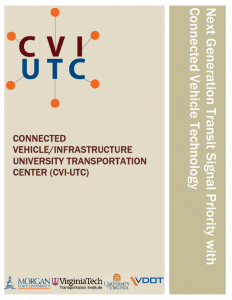The final report for Next Generation Transit Signal Priority with Connected Vehicle Technology, submitted by Dr. Jia Hu, Dr. Young Jae-Lee, Dr. Byungkyu Brian Park, and Seyedehsan Dadvar has been released.
This project utilized connected vehicle (CV) technology allowing two-way communication among vehicles and infrastructure to develop a next-generation Transit Signal Priority (TSP) system that does not have to rely on conventional TSP sensors. The research team extended a previously proposed TSP system based on CV technology (TSPCV) to handle conflicting requests and to coordinate passage between intersections in a travel corridor. The proposed TSP mechanisms minimize installation and maintenance costs by eliminating the need for local agencies to perform a level of service (LOS) study and/or volume/capacity (v/c) ratio for potential TSP intersections before installation. Simulation-based evaluation results showed that, compared to conventional TSP mechanisms, the proposed TSP logic reduces bus delays between 5% and 48% (TSPCVM) and decreases the delay of a bus progressing along a corridor between 35% and 68% (TSPCV-C). The range of improvement corresponds to the four different v/c ratios tested, which were 0.5, 0.7, 0.9 and 1.0. In most cases, the proposed TSP logic caused no negative effects.
A field experiment conducted on the Connected Vehicle test bed on the Virginia Smart Road, located at the Virginia Tech Transportation Institute (VTTI) in Blacksburg, Virginia, validated the performance of the proposed TSPCV system. The TSPCV algorithm provided green traffic signal timing to buses with different arrival times with a 100% success rate. It also reduced delays for a bus with a speed of 45 mph and a traffic signal with a 90-second cycle length and 30 seconds of green time by as much as between 32% and 75%. Moreover, the field experiment showed that two Global Positioning System (GPS) devices (regular and differential) performed almost identically and, in an aggregate sense, the difference in their performance was not statistically significant. This finding facilitates the large-scale implementation of TSP, since regular GPS devices are much cheaper than differential GPS devices and operated just as well for TSPCV.
Click here to learn more about this project and read the final report.
